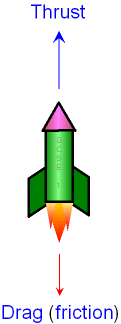
gcsescience.com 20 gcsescience.com
The Forces on a Rocket.
What are the Forces on a Flying Rocket?
The two
forces shown by the arrows in the picture below
are in opposite directions.
The upward force (called thrust) comes from the burning of
fuel
at the bottom of the rocket (see also fireworks).
Hot
gases are forced downwards through the rocket's jets
which pushes the body of the rocket
upwards.
This is an example of Newton's Third Law of Motion.
The bigger the downward blast of gas, the bigger
the force (thrust)
pushing the rocket upwards. A jet engine
works in the same way to push an aircraft
forwards.

The downward force
(called "drag" or "air resistance")
is an example of friction. Friction comes
from the air pushing against the rocket as it moves.
The faster the rocket moves, the bigger the drag
because the air must be pushed out of the way at a faster rate.
There is also a contribution to the downward force
from the weight of the rocket (continued on the next page).
Note that the forces are usually
drawn by arrows
moving away from the
object as if they are pulling on it.
In reality, the thrust is pushing
upward on the bottom of the rocket
and the drag is pushing downwards on the top of the rocket.
It does not matter whether the
arrows are drawn pushing or pulling
as long as they represent the size and
direction of the force.
![]() Links
Forces and Motion
Force
Revision Questions
Links
Forces and Motion
Force
Revision Questions
![]()
gcsescience.com Physics Quiz Index Force Quiz gcsescience.com
Home GCSE Chemistry GCSE Physics
Copyright © 2015 gcsescience.com. All Rights Reserved.